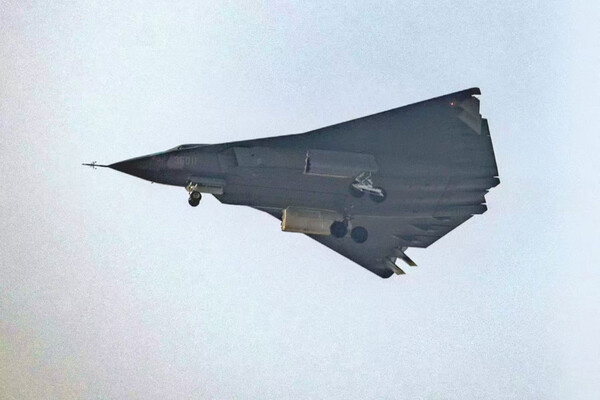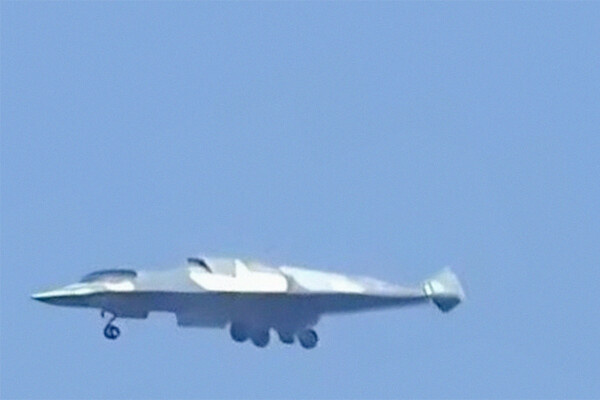China has demonstrated the world's first sixth-generation fighter jet. And not just one, but two at once. Their unusual appearance indicates that Chinese designers are thinking the same way as their American colleagues and are trying to make the aircraft as less conspicuous as possible, but smarter and more intelligent.
Mao's birthday
On 26 December, Mao Zedong's birthday, videos of unusual, futuristic-looking aircraft appeared on Chinese social network Weibo. One of them was seen blurred, allowing only the general silhouette to be seen, but the second one could be seen in fine detail, down to the shape of the edge of the landing gear flaps. Representatives of the Chinese Ministry of Defense and Air Force have not commented on the publication, but Western analysts have concluded that the aircraft in front of them are sixth-generation combat aircraft.
Modern combat aviation is organized in such a way that it is difficult to judge their tactical and technical characteristics from the appearance of aircraft. In the 1950s and 1970s, even a cursory glance at the shape of the fuselage and air intakes was enough for a specialist to understand what the aircraft could do and what danger it posed. Nowadays, the Su-27 and Su-35 are almost identical in appearance, but in terms of combat capabilities there is a huge distance between them.

Therefore, any analysis of the aircraft shown by China is based on a large set of assumptions, which can be very different. For example, one could hypothetically assume that only a prototype has taken to the air to test an unusually shaped airframe, which in itself does not give the Chinese Air Force anything special. But such an assumption is hardly reasonable given what is already known about modern Chinese aviation. Therefore, further text will be built around another assumption: the demonstrated design carries a functional load and is dictated by the requirements for a new generation aircraft. Chinese fighter models are given a J index and a number (J-11, J-20, etc.), but the names of the new aircraft are unknown. For convenience in the text they will be referred to by size, J-B (large) and J-M (small).
The J-B is best seen in the footage. It was flying in the company of a large fifth-generation J-20 fighter, but looked noticeably larger than it. The aircraft is a ‘tailless’ design with a deltoid wing, but it lacks not only a tail but also a vertical plumage, making it look like a ‘flying wing’. A similar scheme has been depicted on concept art of the US sixth-generation fighter, and is believed to greatly reduce radar signature from many angles and in many wavelengths.
The aerodynamic rudders are located in the tail section of the fuselage and are very complex. In the absence of vertical trim, the aircraft must be unstable in yaw (‘left-to-right’), and flight stability can only be maintained by the computer by operating the left or right flaps.
The aircraft has three engines, with two air intakes traditionally located on the sides of the fuselage and one on top. The fuselage looks thick and obviously accommodates a spacious internal weapons bay with a lockable hatch. The sharpest shots show the serrated edge of the landing gear flaps. Such began to be installed on the fifth-generation aircraft, so that the parts in it do not form right angles, greatly increasing radar visibility. The cabin looks large and can presumably accommodate two pilots. A side-view radar is probably mounted to the right and left of the cockpit.
Less is known about the second aircraft, the J-M. It is smaller than the J-B, but also lacks vertical plumage. The wing shape is different and resembles a sharper ‘lambda’ rather than a ‘delta’. According to the first assumption, the J-B is a medium-range multirole fighter-bomber, like the American F-15E or the Russian Su-34, and the J-M is an air superiority fighter. Another assumption is that they are either two competing fighters from different Shenyang and Chengdu firms, or complementary light and heavy fighters, like the F-15C/F-16 or Su-27/MiG-29 pairs.
To explain the advantage of the envisioned sixth-generation aircraft, it is necessary to understand what exactly is important to win in modern air combat.

. To be the first to spot the enemy, an aircraft needs perfect radar (radar) and OLS (optical/infrared camera), and at the same time, stealth in the radio, infrared and optical range. To fire first, you need long-range missiles with perfect guidance systems that fit into internal compartments and preferably in large numbers. Finally, even the best radar will do little without a modern battle management information system, like ALIS on board the F-35.
ALIS can be devoted to a separate material, but in general it is the ‘brain’ of the F-35, which unites both it and the entire U.S. armed forces numerous sensors. Modern technology allows to collect too much information - more than a human being is able to digest in a reasonable time.
The first signal - somewhere a few hundred kilometers away, the enemy has activated a radio communication channel - we need to understand what this means. The second signal - a radiation similar to the enemy radar was detected in another place - it is necessary to classify it accurately. The third signal - the radar in the mode of operation on the ground presumably detected non-radiating enemy anti-aircraft missile system - it is necessary to take it into account. The fourth signal - detected air target, unidentified, presumably enemy, in the kill zone - we must decide what to do with it. Fifth signal - a missile is approaching, evasive maneuvers and interference with its homing head.
In real combat, there may be many hundreds of such signals and to process them in the traditional way requires a headquarters that works slowly. ALIS, a HQ that operates at the speed of a computer, analyses sensor data from the aircraft itself, from other aircraft or from other reconnaissance assets. ALIS determines that three ‘detected an aerial target at this location’ messages from different allied aircraft actually refer to the same enemy aircraft. The computer determines the most important information and displays it on a helmet-mounted display, essentially an augmented reality helmet where, like a computer game, enemies are highlighted and framed. In theory, the same system allows controlling unmanned systems, such as a robotic wingman, which has been under development in the United States for many years.


















